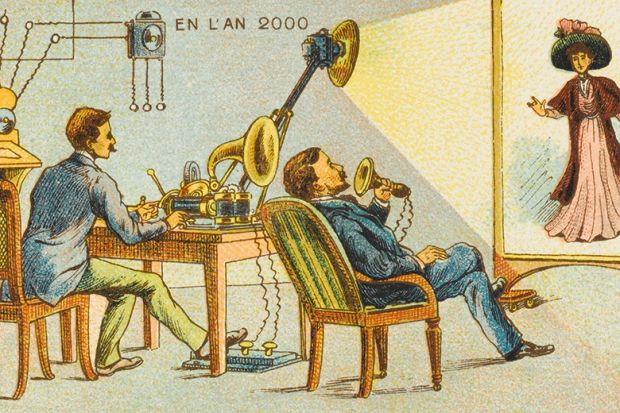The television set, ubiquitous but often overlooked, takes centre stage in Chris Horrocks’ book. He offers a glimpse into how television sets developed from the meeting between technology and culture, becoming both familiar and alien objects in our lives. He asks that we look more closely at them and, in doing so, see them afresh. At a juncture when the future of the television set is being called into question with the arrival of smaller, portable screens, this is a timely contribution.
Dotted with interesting vignettes, The Joy of Sets is a wide-ranging and well-researched book, which provides an unconventional perspective on TV. Television’s earliest manifestations are discussed, including its appearance in Victorian novels as a kind of videophone, akin to modern video-messaging. As well as being a symbol of the future, television was associated with telepathy, clairvoyance and the mystical in the Victorian imagination.
This early history of the television, before it became a technological reality, is often ignored, but Horrocks shows why it remains important for our modern relationship with the TV set. An emphasis on the tension between the material and the immaterial helps to support his central point that television is an object-technology associated with anxiety and mystery.
Other less-explored territories of TV history are discussed, including its development during the Second World War. The Nazis’ use of TV for boosting national morale is particularly striking, with viewing parlours (Fernsehstuben) set up for the German public to come together to watch. Horrocks manages to include examples from across the globe, from Soviet Russia to Brazil. Some of the most colourful come from the US, including advice to television repairmen not to go into the home of a housewife in a negligee and to never accept a drink from one. There is, however, a slight tendency to conflate the history of the television set in the UK and the US, without fully recognising that the British attitude to television was shaped by a fear of consumer culture and “Americanisation”.
Horrocks’ examination of television’s life beyond the home – in particular its appearance in film and art galleries, where he believes that it can serve as a disruptive force – is especially interesting and illuminates its broad place in our cultural imagination. The example of the bullet hole in Elvis Presley’s TV, housed at the Elvis Museum in Graceland, shows the complex relationship that some of us have with the TV. Yet the representation of television as a negative or alien force in art and film could have been challenged, since it can come from a vantage point that is predisposed to criticise “mass” culture.
The ideas raised about “the ends” of the television set could spark new debates on the role the internet may play in our relationship with TV and whether new streaming platforms for receiving content will fundamentally alter the television set’s material form.
Emily Rees is a PhD candidate in the department of culture, film and media at the University of Nottingham.
The Joy of Sets: A Short History of the Television
By Chris Horrocks
Reaktion Books
224pp, £20.00
ISBN 9781780237589
Published 5 March 2018
Register to continue
Why register?
- Registration is free and only takes a moment
- Once registered, you can read 3 articles a month
- Sign up for our newsletter
Subscribe
Or subscribe for unlimited access to:
- Unlimited access to news, views, insights & reviews
- Digital editions
- Digital access to THE’s university and college rankings analysis
Already registered or a current subscriber?




